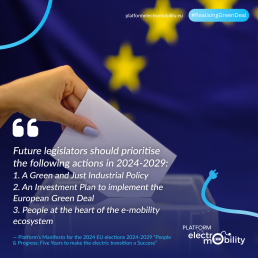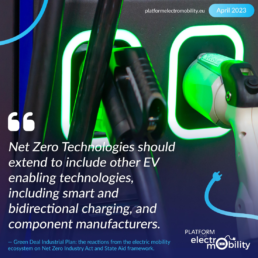EU Election Manifesto: A Green and Just Industrial Policy
11th September 2023PublicationsEU Industrial Strategy
Manifesto First Pillar
A Green and Just
Industrial European Policy

One of the richest ‘urban mines’ available to Europe is the supply of old batteries and other waste materials. By investing in integrated recycling and repurposing facilities for collecting, dismantling, recovering or reusing valuable metals from batteries, Europe can, by 2040, secure a large share of the metal resources it needs for battery production. Such an approach not just reduces waste, it is also scalable, preserving and reusing precious raw materials and keeping a greater proportion of them within Europe, increasing our strategic autonomy.
The overall concept of Europe keeping potentially valuable waste within its borders is one that should be widely adopted. Environmental recycling standards vary; exporting waste for processing to locations without equivalent standards undermines our own attempts to reduce environmental impacts. The EU should encourage recycling by establishing a harmonised approach to the intra-EU shipment of spent batteries. All. Executed properly, this can make Europe competitive in battery recycling, ensure the highest environmental standards and help create a flourishing recycling industry in the future
Resilient, affordable renewable energy will be key to a successful industrial policy; however, this demands that the correct grid assets are in place. With a European Grids Package, Europe can refresh and upgrade its infrastructure to meet the demand to accommodate higher levels of renewable energy. Although this will require investment, doing so will allow Europe to tap into its future grid asset – electric vehicles. It will accelerate the connection of chargers and other Green Deal enabling technologies and allow Europe to tap into the huge energy storage potential offered by electric vehicles.
Europe must also go further than simply reducing vehicle engine emissions; it needs a more-holistic approach to reducing the environmental footprint of all road vehicles. This means decarbonising manufacturing materials, increasing manufacturing efficiency and maximising the circularity of the materials used. Introducing digital product passports, revamping EU products policy to reduce environmental footprints and committing to deliver a strong end-of-life vehicles regulation based on low carbon and recycled materials, will be the key drivers for such change in the years ahead.
Finally, while a renewed European industrial policy has focused on key components and sub-systems, it is important that it considers the full scope of the mobility industries’ value chains supporting their global competitiveness as they address the green transitions.

EU Election Manifesto: Introduction
11th September 2023Uncategorised
Manifesto introduction
Now is time to
put Green Deal into action

The agreement to pursue zero emissions for Europe’s new cars and vans by 2035 has set a clear direction and an unequivocal target for sustainable transport measures; with the last legislative session providing backing for the European Green Deal. We fully back these efforts, and urge support through enhancements to the existing charging infrastructure, the development of alternatives such as a strong rail network and a sustainable batteries value chain.
However, in order to make the Green transition a reality, and bring its benefits to people, the planet and business, it is vital that we act now. Making the transition to e-mobility must be a priority, not simply to deliver environmental sustainability but also to reinforce the EU’s industrial strength, security and competitiveness.
Now is the time to put the Green Deal into action
The Green Deal, its technologies and fully electric transport modes will significantly reduce Europe’s dependency on fossil fuels. Recent geopolitical events have shown the importance of ensuring energy security and resource independence.
The Green Deal will also make the EU a global leader in the sustainable transport industries. It will position Europe as an authoritative voice on the need for climate change action while bringing welcome economic growth and the creation of high-quality jobs.
The Green Deal will allow Europe to prioritise the quality of life of its current and future workforce. This will see the highest social standards put in place to protect the interests and livelihoods of Europe’s workers, both now and as part of a sustainable future.
An effective green industrial policy will bring the benefits of Europe’s Green Deal to all.
Continuing and rapid decarbonisation is crucial: but it must be done in such a way that preserves Europe’s competitiveness. Nowhere is this more important than in transport and mobility. The Platform for electromobility – an alliance of companies, cities and NGOs – brings the knowledge and expertise to make an effective and efficient mobility transition a reality.

[Video] Peter Badik (GreenWay) on Electricity Market Design
Electricity Market Design
Peter Badik, CEO of GreenWay, on the importance of the reform of the Electricity Market Design.
The Platform for electromobility, uniting industries, civil society organisations and cities from the transport, energy and clean tech sector, welcomes the Electricity Market Reform (EMD) proposal as an important opportunity to support the build-out of grid-friendly e-mobility across Europe. We appreciate the proposals improve the existing electricity market framework in a way that facilitates cost-effective deployment of individual or aggregated smart and bidirectional electric vehicles (EVs) charging. As the EV market is growing rapidly, smart and bidirectional charging will quickly become one of the most important sources of demand-side flexibility. In the collective European effort to decrease fossil gas imports, EV charging flexibility will be instrumental to reduce consumer costs, greenhouse gas emissions and better integrate solar and wind in the grid. Importantly, by offering additional revenues or cost saving opportunities to EV owners, the reform accelerates EV take-up and the clean transport transition.
The Platform therefore urges co-legislators to keep the level of ambition and a swift adoption. The European Commission’s EMD reform proposal supports the uptake of e-mobility in the following ways:
The reform recognises EVs as flexibility resource
Member States will have to make a detailed assessment of the needs and the potential of demand-side response and storage. Based on the assessment, an indicative objective shall be set and supportive measures, such as a flexibility support scheme, may be introduced. It is important to properly include EVs as a source of demand response and storage in both the assessment of the flexibility needs and the objective for demand response and storage, and ensure appropriate participation of EV stakeholders in these assessments processes.
The reform further supports the participation of EVs in the markets
The threshold for participation in the day ahead and intraday markets get lowered to 100 kW, which makes them more accessible to aggregations of EV fleets. This will help develop the market for user-centric smart and bidirectional charging services. It may be advisable to extend this lower threshold also to capacity markets.
The reform accelerates planning for EV charging infrastructure
Transmission and distribution system operators will be financially incentivized to fully consider local demand side resources, such as EVs, when looking for solutions for grid congestion. System operators will propose further transparency and proactivity on their planning for connecting EV charging infrastructure, for example by sharing hosting capacity available for EV charging. This is essential information for providers of EV charging services and helps accelerate grid-efficient build-out of EV charging infrastructure.
Greening Corporate Fleets Initiative: support to the launch of a public consultation
The Platform for electromobility supports the launch of a public consultation on the Greening Corporate Fleets Initiative .
The members of the Platform for electromobility, a leading advocate for sustainable mobility and environmental development, hereby publicly expresses their strong support for the Greening Corporate Fleets Initiative included in the European Commission’s work program for 2023 and called for by the European Parliament in May 2022.
We understand that it will be difficult to launch and complete this initiative before the end of the Commission’s mandate in 2024. We would however very positively welcome the launch of a public consultation on this very important topic to collect as much data and information to guarantee the success of such an initiative at a later date.
The Greening Corporate Fleets Initiative represents a vital step toward accelerating the transition to electric mobility, ensuring a sustainable future for both our environment and society. By calling for a comprehensive framework for corporate fleet emissions reduction, this initiative aligns with our previous policy recommendations on the matter (the reasons, the concerns and the methods). We firmly believe that it presents an excellent opportunity to drive meaningful change while safeguarding the interests of the most modest individuals who should not bear the sole burden of the transition.
The environmental benefits of the Greening Corporate Fleets Initiative cannot be overstated. By incentivizing and supporting the adoption of electric vehicles across corporate fleets which are now electrifying slower than private vehicles[1], we can significantly reduce greenhouse gas emissions and limit the impacts of transportation on our climate. This aligns with the ambitious climate targets set forth in the European Green Deal.
Furthermore, the social aspect of this initiative should not be overlooked. By focusing on corporate fleets, the Greening Corporate Fleets Initiative ensures a fair distribution of the costs associated with the transition to greener mobility solutions. As stated above, by shouldering a portion of the burden, corporations can contribute to building a more sustainable future while least-well-off families are not unduly burdened by the costs of this transition.
Moreover, the initiative’s emphasis on creating a robust second-hand market for electric vehicles is commendable. A thriving secondary market for EVs will not only enhance the affordability of these vehicles but also encourage the wider adoption of clean transport solutions. By stimulating the circular economy, this initiative will unlock significant economic and environmental benefits.
In conclusion, the Platform supports the Greening Corporate Fleets Initiative and encourages DG MOVE to promptly initiate a public consultation on this crucial matter. We believe that by working collaboratively, policymakers, industry stakeholders, and citizens can co-create a sustainable mobility landscape that fosters environmental stewardship, social equity, and economic growth.
[1] https://www.transportenvironment.org/wp-content/uploads/2023/05/Briefing-on-Fleets-Regulation-3.pdf
Weights & Dimensions Directive: ACEA, Platform for electromobility and Hydrogen Europe call it a priority in a joint letter
Open letter
Calling co-legislators for swift progress on the revision of the Weight and Dimensions Directive
To European Commission Executive Vice-President for the European Green Deal, Frans Timmermans
To the European Commissioner for Transport, Adina-Ioana Vălean
To Ambassador and Permanent Representative of Spain to the European Union, D. Marcos Alonso Alonso
To the Presidents of the TRAN and ENVI Committees of the European Parliament, Karima Delli and Pascal Canfin
To the Presidents of the European Parliament Political Groups,
Dear,
We, the undersigned representatives from the European Automobile Manufacturers’ Association (ACEA), the Platform for electromobility and Hydrogen Europe, representing the majority of industry stakeholders and civil society in vehicle manufacturing, direct electrification and hydrogen value chain, are writing to highlight the crucial role of establishing a full set of enabling conditions to support the transition of the European road transport industry to climate neutrality by 2050. The Review of the Weights & Dimensions (W&D) Directive is one crucial element of the regulatory framework to facilitate the market uptake of zero-emission, battery-electric and hydrogen-powered trucks and buses. We are concerned that any further delays and persistent uncertainty surrounding a timely adoption and implementation of a revised Weights and Dimensions Directive would be detrimental to our joint climate neutrality ambition and the EU target of 90% transport emission reduction by 2050.
Zero-emission vehicles (ZEVs) will have to become the backbone of road transport if the sector is to reach its decarbonisation targets. Zero-emission vehicles (ZEVs) come with additional requirements with respect to available space in the vehicles, total vehicle weight and axle weights. These ddifferences to vehicles powered by fossil fuels should be addressed in the review with an aim to remove any barriers that can hinder their market uptake and firmly place them on a level playing field with vehicles powered by fossil fuels.
The Review should specifically:
- Simplify the Directive as much as possible and ensure a fully harmonized implementation in Member States
- Provide additional weight allowances for zero-emission vehicles and adjust the provisions for axle weights and vehicle length to accommodate the requirements of zero-emission powertrains.
- Ensure intermodal compatibility in the revision of the Weights & Dimensions Directive.
The Weights & Dimensions Directive must be seen as a key enabler of the transition to climate neutrality and should as such also be acknowledged by the co-legislators.
ACEA, the Platform for electromobility, and Hydrogen Europe are united in calling on the European institutions, namely the European Commission, the incoming Spanish Council Presidency, the European Parliament and EU Member States to prioritize making the necessary adjustments in the Weights & Dimensions framework. It is imperative that progress is made swiftly to remove barriers in the Weights & Dimensions framework that may hinder the market adoption of zero-emission trucks and buses.
We trust that you share our sense of urgency and will take the necessary steps to ensure that Europe establishes a coherent and supportive regulatory framework to enable the swift decarbonisation of road transport and seizes the opportunities provided by sustainable mobility.
Sincerely,
Our statement on the reform of the Electricity Market Design
16th June 2023PublicationsEnergy
Electricity Market Design
The Platform for electromobility urges ambitious adoption of EMD reform to drive grid-friendly e-mobility
The Platform for electromobility, uniting industries, civil society organisations and cities from the transport, energy and clean tech sector, welcomes the Electricity Market Reform (EMD) proposal as an important opportunity to support the build-out of grid-friendly e-mobility across Europe. We appreciate the proposals improve the existing electricity market framework in a way that facilitates cost-effective deployment of individual or aggregated smart and bidirectional electric vehicles (EVs) charging. As the EV market is growing rapidly, smart and bidirectional charging will quickly become one of the most important sources of demand-side flexibility. In the collective European effort to decrease fossil gas imports, EV charging flexibility will be instrumental to reduce consumer costs, greenhouse gas emissions and better integrate solar and wind in the grid. Importantly, by offering additional revenues or cost saving opportunities to EV owners, the reform accelerates EV take-up and the clean transport transition.
The Platform therefore urges co-legislators to keep the level of ambition and a swift adoption. The European Commission’s EMD reform proposal supports the uptake of e-mobility in the following ways:
The reform recognises EVs as flexibility resource
Member States will have to make a detailed assessment of the needs and the potential of demand-side response and storage. Based on the assessment, an indicative objective shall be set and supportive measures, such as a flexibility support scheme, may be introduced. It is important to properly include EVs as a source of demand response and storage in both the assessment of the flexibility needs and the objective for demand response and storage, and ensure appropriate participation of EV stakeholders in these assessments processes.
The reform further supports the participation of EVs in the markets
The threshold for participation in the day ahead and intraday markets get lowered to 100 kW, which makes them more accessible to aggregations of EV fleets. This will help develop the market for user-centric smart and bidirectional charging services. It may be advisable to extend this lower threshold also to capacity markets.
The reform accelerates planning for EV charging infrastructure
Transmission and distribution system operators will be financially incentivized to fully consider local demand side resources, such as EVs, when looking for solutions for grid congestion. System operators will propose further transparency and proactivity on their planning for connecting EV charging infrastructure, for example by sharing hosting capacity available for EV charging. This is essential information for providers of EV charging services and helps accelerate grid-efficient build-out of EV charging infrastructure.
[Video] Matteo Barisione (UNIFE) on Net Zero Industrial Act
Net Zero Industrial Act
Explained by Matteo Barisione, UNIFE
The Net Zero Industry Act, a mere response to the U.S. IRA?
Matteo: Yes and No. The Commission’s proposal goes beyond a mere response to the American Inflation Reduction Act. It is an accelerator for clean tech using regulatory rather than financial measures. And the Platform really sees the proposal as an enabler for a competitive transition to electric mobility.
But in its scope, the Net Zero Industry Act mirrors the IRA too much. It needs to consider European transport system specificities and the whole value chain of e-mobility.
Third screen: How to improve the Net Zero Industry Act?
Matteo: Although we welcome the inclusion of batteries, charging infrastructures and grid technologies as Strategic Net Zero Technologies, we remain concerned about the lack of recognition of the entire electric mobility value chain: Net Zero Technologies should extend to include other EV-enabling technologies like V2G component manufacturers, and – as you can see we chose to talk today from a rail station – all zero-emission modes.
Forth screen: Extending the scope at the expense of existing sectors?
Matteo: Because the Act is a regulatory tool, not a financial one, extending its scope does not take anything away from the sectors already included.
In recent position papers, we detailed the financial and non-financial measures the co-legislators should bring up to make this industrial act truly European – so do go check it out!
[Video] Giovanni Matranga (ENEL Group) explains the CO2 Standards for HDVs
CO2 Standards for HDVs
Explained by Giovanni Matranga, chair of WG Logistics & buses
Is the CO2 Standards for HDV ambitious enough?
Givoanni: CO2 Standards are a crucial piece of legislation to make sure that heavy road transport will make its part to the achievement of the EU climate goals. New standards are undoubtedly needed to set the right pace and a clear trajectory for everyone: manufacturers, logistics operators and the whole supply chain.
For us the platform, considering the average lifespan of a truck of roughly 15 years, it’s imperative to respect climate goals that almost all newly registered trucks should be 100% zero emission by 2035.
Regarding urban buses, we welcome the Commission’s strong ambition, although some improvements must be performed for a proper transition to zero-emission buses in cities.
What about the new definition of zero-emission vehicle?
Giovanni: I am sorry that I may be a bit technical here, but a key point is the new definition of “zero-emission vehicle”, that would consider trucks and buses emitting 5 grams of CO2 per tonne-kilometer as zero-emission vehicles. In our platform view, this could create a dangerous loophole and allow the sales of polluting vehicles even after 2050 and lead to greenwashing practises.
How to know more?
Giovanni: If you are still watching this video, I have good news for you. On the 23rd of May, Members of the European Parliament, the European Commission and representatives of the trucks and buses industries will gather in a policy conference organised by the Platform for electromobility. Don’t miss your chance to participate in the discussion by registering on our website.
The reactions from the electric mobility ecosystem on Net Zero Industry Act
1st May 2023PublicationsEU Industrial Strategy
Green Deal Industrial Plan:
the reactions from the electric mobility ecosystem on Net Zero Industry Act and State Aid framework.
The Platform for electromobility welcomes the European Commission’s Net Zero Industrial Act (NZIA) and Temporary Crisis and Transition State aid Framework (TCTF) for accelerating the transition of the EU’s net zero industrial sectors towards climate neutrality by 2050. As currently proposed, the NZIA is a positive start for a necessary holistic and long-term strategic plan, detailing specific financial and regulatory support measures for addressing all global current and future challenges, securing an EU-built industrial ecosystem of sustainable transport and ensuring bespoke strategic autonomy for every key sector identified.
We understand and welcome the package of both NZIA and TCTF as a tool for accelerating clean-tech industries with proposed non-financial regulatory measures. In this paper, we outline how the narrow scope of the proposed NZIA may fail in its aim of supporting European specificities. In addition, certain financial measures should also be included; without these, the NZIA may fall short of achieving its intended goals and fail to provide the required support for European clean industries.
Scope
Given the importance of reducing greenhouse gas emissions from the transport sector and industries, and the fact that Europe’s transport systems make up part of its critical infrastructure, we consider that mobility industries that provide zero-emission vehicles (ZEV) – all transport modes considered – as well as charging stations, software and other ZEV enabling tech, should be considered part of the ‘Clean Tech’ sector.
We welcome the inclusion of battery, charging infrastructures and grid technologies in the Annexes as Strategic Net Zero Technologies, yet we remain concerned about the lack of recognition for the entire EV value chain in the proposal. Net Zero Technologies should be extended to include other EV enabling technologies, including smart and bidirectional charging as well as component manufacturers.
A more flexible approach to those sectors that will be key for the EU’s future competitiveness should be adopted. Downstream industries, such as ZEV manufacturers, should be better considered and included in the scope of the Regulation to secure economic opportunities for supported upstream industries, such as cell manufacturing. Considering the NZIA as a non-financial tool, extending the scope to other sectors of the energy transition would increase Europe’s ability to be competitive in strategic sectors for the decarbonisation of transport, without undermining the support of already-included sectors such as battery manufacturing.

Non-financial measures
To create the enabling conditions for the European clean transport industry to prosper, several issues must be urgently tackled.
The Green Deal is the EU’s centrepiece climate policy. It is now necessary to provide the regulatory certainty for businesses that will allow them to invest in the transition of the EU economy to a sustainable model that is consistent with the 2050 target of climate neutrality. Europe should lock-in ambitious Green Deal Fit for 55 policies (including the Trans-European Network for Transport Guidelines revision, the 2035 zero-emission objective for new cars and vans) and introduce similar policies for trucks and non-road mobile machinery in order to phase-out fossil trucks between 2035-40.
As specified in the proposal, and in order to ensure regulatory certainty, it is important that Member States endorse and adopt legislative and non-legislative actions relating to the Green Deal Industrial Plan. Such actions should be incorporated into national planning processes and should prioritise clean industries in energy and climate plans. New measures should also align with existing governance regulations and contribute to national energy and climate goals. National Recovery Resilience Plans should address the new elements from upcoming regulations, and the ways in which clean value chains can support energy and climate targets.
For the forthcoming mid-term revision of the Multiannual Financial Framework, we welcome recent guidelines pushing Member States to amend National Recovery and Resilience Plans towards energy independency via renewable energy deployment and greening industries. Given the strong synergies between renewable energies and electric mobility, the former will inevitably form a key pillar of a European sustainable, electric transportation system.
We welcome NZIA’s measures for reducing unwieldy bureaucracy and speeding up overly cumbersome and slow procedures for the granting of permits, through national single points of contacts and maximum durations for permitting procedures. The ‘regulatory sandbox’ approach for new technologies can also help support their faster market readiness.
More could be done, however, through a critical review of the sectoral regulation applicable to existing zero-emission industries or technologies, to accelerate product development, capacity for sustainably extracted raw materials and renewable energy, validation, certification and market access, wherever possible. Sectoral action plans could draw on the Mobility Ecosystem Transition Pathway released by the Commission in March 2022.
In order to fast-track best-in-class projects, we welcome that Member States will be required to appoint a contact person for net zero strategic projects.
For modernisation, more should be done to digitalise the approvals process and to increase expertise and skills in local and national authorities.

The Platform supports provisions oriented towards a more binding approach to sustainability / Most-Economic Advantageous Tender (MEAT). The NZIA proposes specific sustainability and resilience criteria that public authorities need to take into account during public procurement procedures, in addition to price or cost. Public authorities shall give the tender’s sustainability and resilience contribution a weight of between 15% and 30% of the award criteria. This goes beyond the only price criteria, and is aligned with the MEAT principle, which is of great importance for the transport sector.
The question of which criteria for which technology should not be tackled in great detail within the NZIA, but rather in some upcoming guidelines from the European Commission. These would support public procurement authorities grasping sustainability and resilience criteria.
In the longer term, improved coordination between universities and industries on European research strategies and priorities is essential: Europe is home of many leading research institutes, but the research sector is overly fragmented to be able to outperform some global regions in the race to develop clean tech. The role of Horizon Europe and of Public-Private Partnerships should be reinforced to address this. European research institutes are also vital in equipping the European workforce with necessary skills for the transition.
The introduction of Net Zero Academies in the NZIA goes in the right direction, but these would require more details and specification. For example, the United States’ IRA has conditionality measures to link public support with social policies at company level. The EU should support companies in their commitment for upskilling and reskilling their workforce. It should foster and promote synergies between public and private sectors, in order to create training programmes fit for the net-zero value chain, such as the ReKnow University.
Financial measures
We welcome the simplification of EU State Aid rules in terms of Aid intensity, eligible costs definition and higher thresholds for State Aid exempted from prior notification for a temporary period. This is a useful immediate measure that will support investments in the electromobility value chain in the EU.
Subsidies should be granted to projects that match a certain set of conditions. This way, public funding (to support Operational Expenditure – OpEx and Capital Expenditure – CapEx) will be directly linked to key parameters for ensuring the competitiveness and resilience of Europe’s electromobility industries for all transport modes. This will be in line with EU targets on, for example, sustainability and R&D&I as well as health, safety and environmental standards.
Specifically on batteries, we support the changes introduced in the revised Temporary Crisis and Transition Framework, which – if leveraged effectively by countries – have the potential of loosening national state aid rules to support EU-based battery production. Financial support should focus on the processing and refining of those battery materials required within the European Union. To ensure predictability and bankability for companies looking to invest in EU-based battery material production, any financing mechanism should be based on clear, pre-determined criteria and focus on output production, similar to the production-based incentives (USD/kWh) introduced by the US IRA.
However crucial the update of State Aid rules may be, the requirement to preserve a level-playing-field between European companies based in different Member States, since some are more fiscal liable and thus more likely to subside industries than others. Fragmentation of the internal market is a genuine risk:
Consequently, European competitiveness and a level European playing field require joint EU funding to ensure a pan-European investment capacity. The future European Sovereignty Fund must be established in close coordination with European clean tech industries, to ensure its cost-effectiveness, added value and complementarity with existing EU funds. ZEV-related supply chains, refining and processing materials for battery production capacity and related grid upgrades should be priority sectors for its operations, and inspiration should be drawn from the simple support provided, for example, in the US IRA, with its Advanced Manufacturing Production Credits. Without such matching of funds, there can be no global level-playing-field for battery manufacturing.
Financial measures should prioritise the development of a European battery value chain, including cell and component manufacturing, critical metals refining and processing. This should introduce minimum production targets for companies manufacturing in Europe (this can be via tax breaks or grants to scale-up manufacturing, or direct subsidies for startups who could be excluded from tax credits/deduction due to limited taxable income), uphold Europe’s environmental acquis and remain focused on the most value-added parts such as cathodes and cathode precursors. Batteries are central to scaling up ZEV and renewables. Missing this value chain to Asia or the US will undermine Europe’s strategic resilience and exclude the bloc from the resulting industrial and jobs benefits.
For battery manufacturing, the US IRA provides an Advanced Manufacturing Production Credit (Opex support) of $35/kWh produced. We call for EU policymakers to match such support in order to help its European battery industry compete on more equal terms. Without such matching, there can be no global level-playing-field for battery manufacturing.
In parallel, Europe’s competitiveness and leadership on downstream industries (road and rail vehicles manufacturing) must be enhanced through dedicated, co-created action plans. Europe should also reward an accelerated implementation of the carbon footprint, circularity and due diligence provisions in the new EU Battery regulation by targeting subsidies at companies leading on sustainability.
Funding should support urgently-needed investments in grid upgrades and capacity, training and reskilling. There should be a specific focus on ensuring that workforce shortages in the electrical and software sectors are urgently addressed. This should go beyond financial mobilisation through the existing opportunities set out by the European Commission (Innovation Fund, Invest EU, Recovery and Resilience Facility; Horizon Europe and cohesion policy programmes), which have not yet reached convincing scale or momentum. To support its ambitions, the European Commission should come forward with a concrete funding plan/guideline to support the deployment of Net-Zero Technologies.




